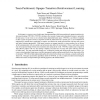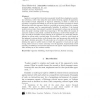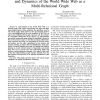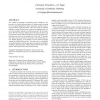145 search results - page 21 / 29 » Adversarial learning |
AAAI
2006
13 years 9 months ago
2006
While computers have defeated the best human players in many classic board games, progress in Go remains elusive. The large branching factor in the game makes traditional adversar...
AGENTS
1999
Springer
13 years 12 months ago
1999
Springer
In this paper, we present a novel multi-agent learning paradigm called team-partitioned, opaque-transition reinforcement learning (TPOT-RL). TPOT-RL introduces the concept of usin...
AAMAS
2005
Springer
13 years 7 months ago
2005
Springer
Agents in a competitive interaction can greatly benefit from adapting to a particular adversary, rather than using the same general strategy against all opponents. One method of s...
SOCIALCOM
2010
13 years 5 months ago
2010
A representation of the World Wide Web as a directed graph, with vertices representing web pages and edges representing hypertext links, underpins the algorithms used by web search...
CCS
2005
ACM
14 years 1 months ago
2005
ACM
We examine the problem of keyboard acoustic emanations. We present a novel attack taking as input a 10-minute sound recording of a user typing English text using a keyboard, and t...




